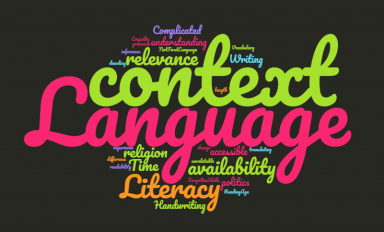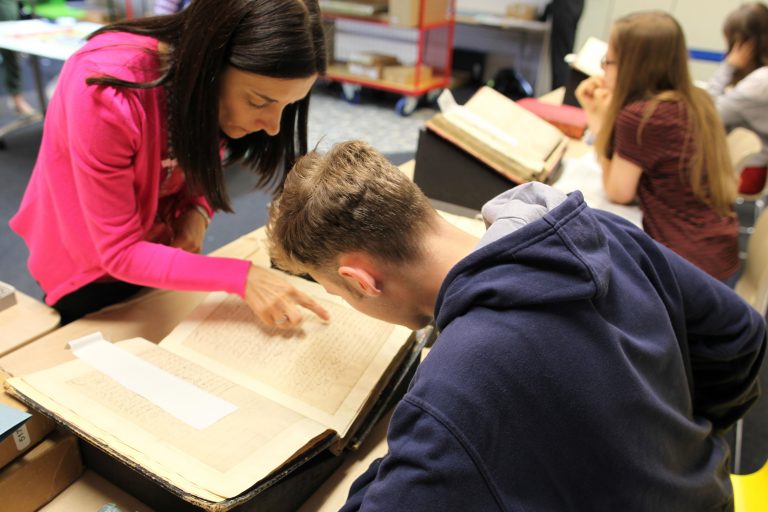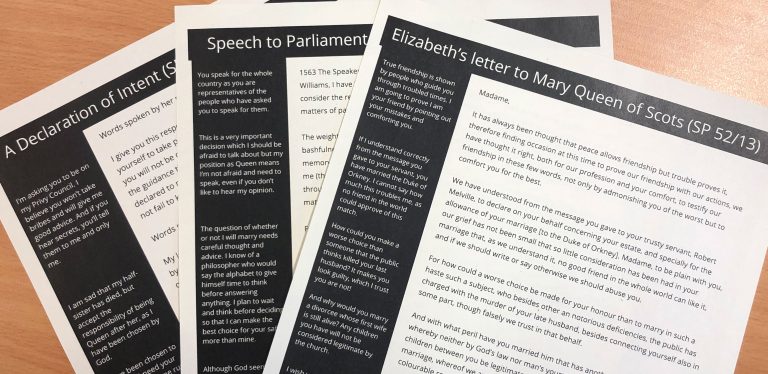The National Archives Education Service works with thousands of school students both on site and online, organising workshops and developing educational resources to download and use in the classroom. Over the past year I have been combining my role as Education Web Officer with my Professional Research Fellowship, supported by Research Libraries UK and The National Archives, looking to improve our educational resources by exploring the specific needs of students attempting to use our Medieval and Early Modern records.
Currently we have ten workshops and 65 resources on our website for teachers to use Medieval and Early Modern documents with their classes, all based on our collections. These allow students to explore digitised records and learn through historical enquiry.
Some of these documents can be difficult to read and we often observe students skipping straight to the modern transcript in our workshops on site. My research, therefore, was aimed at finding ways to support students with the use of original (and digitised) documents. These new resources will inspire and empower students, equipping them with the skills to read early scripts for themselves.

Word cloud: ‘I think the thing that my students find most difficult about using primary sources is…’
To begin I wanted to examine the experiences of the students and teachers using our documents. I created surveys and shared them on our Facebook and Twitter. We had a fantastic response from teachers of all levels, many of whom hadn’t used our service before, and also received replies from GCSE and A Level students who could provide a glimpse into the student perspective.
The overwhelming response from teachers was a concern over time pressures and the ability of their students to understand the language and context of the document. In a tight timetable, many teachers felt they weren’t able to translate unfamiliar language, or provide the necessary background to make documents accessible to the students. A textbook provides a paragraph of contextual information with a line of quotation from a document as evidence – this is much quicker for a student to understand than them attempting to decode a page of difficult text with less direct relevance. Yet this approach doesn’t allow students to think beyond the information provided or question interpretations based on evidence.
Students suggested that they liked using a blend of transcript and document but the language is often difficult to understand. Many would try to read some words from the original or consider the layout or style of the document before reading the transcript, but even a typed version could be difficult to decipher. Students expressed interest in learning some Latin, French and Medieval English words if it would help their understanding.
‘[Using documents] gives an insight into a world we do not usually have access to, allowing us to understand history from the perspective of the individual.’ – A Level student.
The challenge then is how to address these barriers and help to support students and teachers attempting to use the resources we make available. Documents in Latin or French will always need translating, but many of our documents are written in English, even if it is hard to recognise at first.
After reading literature on using archival material in education, it struck me that very little palaeography is taught for younger students, with most encountering it for the first time in their undergraduate or postgraduate degrees. While this is fine to give an in depth look at the history and development of writing, the actual skill of recognising letters in certain documents is what seems to be holding younger students back and could be introduced in History lessons.

A teacher helps a student working with a Tudor document
Our first resource took the form of alphabet reference sheets for students to use alongside original documents in our workshops. We tested this with our Enquiring into Elizabeth ‘mystery document’, using letters from the record itself to provide a reference for students who were trying to work out what the document was about. Immediately students (and their teachers) embraced the sheets, searching for letters they didn’t recognise, and accessing the document far quicker than they had previously been able to. Students seemed to really enjoy decoding the document and felt confident enough to work out some of the meaning before moving to a transcript.
This sense of achievement can be really powerful in developing a love of history and a desire to carry on with the subject, hopefully providing a memorable and enriching experience in their visit to us that could be replicated in the classroom with our digitised copies. I am currently working with Durham University’s 4Schools team at Palace Green Library to create similar resources to support the use of archival materials in their workshops.

New transcripts ready for use in workshops
I then wanted to look at our transcripts and at how accurately they provide a sense of their original document. We use a variety of transcripts in our sessions, some showing a word for word transcription – even in their original spellings – while others are simplified or condensed to make the ‘meaning’ of the document clearer.
Some are also taken from aids such as the calendar of state papers, which often include summaries written in the Victorian period rather than accurate transcriptions. These, while easier to use for students with lower literacy levels, did not always seem to provide the full enriched information available in the original. Consequently we have been creating a prototype of a new ‘glossed’ transcription – where the main text uses the original words from the document with modernised paragraphing and grammar to help students keep track of sentences which were often broken by additional clauses, while a side panel offers simplified summaries of each paragraph to suggest a meaning for students who may struggle with the language.
This transcript offers students more independence to self-select their level of understanding and work without needing support from their teacher. Key passages more likely to be used in textbooks are presented in bold to draw attention to the main sections of the document relevant to particular enquiry questions.
I am currently investigating methods of providing more context for documents, using different methods of displaying digitised materials such as digital mapping, to offer an idea of how a document fits in to a national picture. This resource, and others including palaeography guides and improved transcripts, should be made available online in the next few months following the conclusion of my research project and will be promoted to teachers for use in classrooms. I hope these resources prove useful and open possibilities for more students to explore the fascinating materials we hold within our collections.